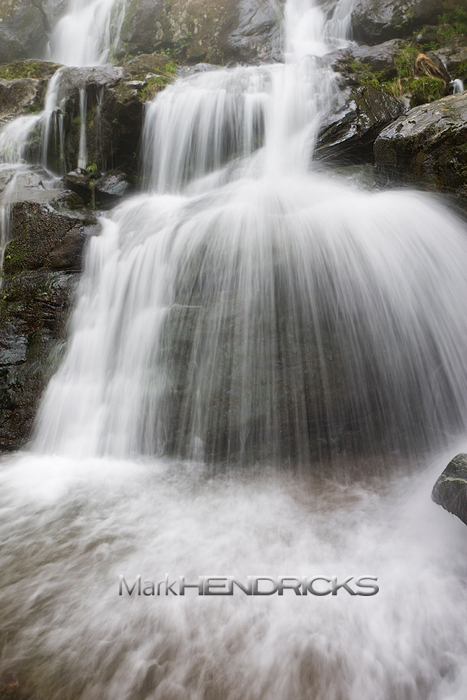“Aww f&@#,” says my wife of almost 4 months, “Are you kidding me?! Thirty degrees!”
My wife has just woken up after a nap while I drive up an unpaved mountain road. This reaction to the frigid weather is just the beginning. What began as an ascent surrounded by brilliant fall colors of numerous deciduous trees has given way to red spruce forest. As my Jeep reaches its destination at about 4,000 feet in elevation it begins to hail.
Red Spruce among the boulders of the Dolly Sods Wilderness
My wife is from South Florida. She loves blue seas, palm trees, the everglades, and sunshine. If it gets below 75 degree, well, it’s cold. So you can imagine her reaction to seeing the sky send us the ominous hail.
If only someone purchased for me some head phones that block out extraneous noise as a wedding gift.
(Note to wife: Just kidding, honey. I love you very much.)
It is the first week of October and most areas around the Chesapeake Bay are hovering in the low 60 degree range. Mild weather, crisp air, and delicious apples are peaking in taste. But on the far western boundary of the Chesapeake Bay Watershed lies an area that is unlike any other in the entire watershed. This area is more akin to a Canadian ecosystem. High above on the Allegheny plateau, we are camping in the Dolly Sods Wilderness of West Virginia.
There is no Dolly, but there are plenty of sods and it is one of my favorite designated wilderness areas. The wilderness lies within the Monongahela National Forest and parts of the Dolly Sods are preserved by the Nature Conservancy. Water that drains from the eastern border of the wilderness flows into the Potomac River and eventually makes its way to the Chesapeake Bay. The weather is unpredictable and can change from calm to snow or from rain to flood, and sometime all four within an hour. This capricious quality is highly influenced by the Potomac River. Because of where the Dolly Sods is located along the Allegheny Plateau it receives Canadian wind from the Northwest that collides with warmer air rising from the Potomac. The end result is very extreme, and very windy, weather. Along the rim of the plateau many spruce trees have taken on a flag form appearance due to the constant bombardment of fierce, cold winds. The banshees like wail of the wind against my tent on this particular camping trip inspired me to originally write this piece around Halloween time.
The Forest floor of the Solly Sods showing plants more common in the arctic
To view the vast landscape of the Dolly Sods is nothing short of breathtaking. Upon first glance you might think you are standing in the expansive Alaskan tundra because of similar flora and fauna. Besides spruce and fir trees, there are miles of blueberry and huckleberry bush, sphagnum and reindeer moss, cranberry bogs, heath barrens, and incredible wind swept boulder formations.
The area has had an interesting history. Most of the old growth spruce forest is gone due to logging (most of the vegetation you see is second growth forest) and in the 1940’s the area was used by troops in the US Army as grounds for artillery and mortar training. Live mortars may still exist in the sods, two were recovered in 2006. Land to make the wilderness was acquired over the years by the nature conservancy (parts of it are overseen by the US Forest Service and the Nature Conservancy).
Fall foliage in the lower elevations is incredibly spectacular. Rivaling that of New England, the leaves turn in mid to late September and among the best I have ever seen. In the higher elevations, the tundra like appearance is striking. The miles of blueberry bush turn scarlet red contrasted amongst the green of the spruce. Along the more moist areas strands of Balsam Fir are found as well.
Fast forward to our current camping trip. My wife, while complaining she cannot handle cold, is quite resilient and we had the tent up in a matter of minutes. We hiked, camped, made s’mores, froze, and had another wonderful time there. The hiking in this area is always great but one must be careful as many of the trails are not, or barely, marked. It is recommended that one take topographic maps made by the US Geological Survey, but do not let that deter you, as the Bear Rocks Preserve area of the wilderness is easily accessible. However if you are a backpacker the area offers some of the wildest and most beautiful camping opportunities.
Previous trips to this area were always cold-but nothing like this. With the wind chill the temperature hovered around 15 degrees. Water that filled the openings in the boulders was now ice. Any skin exposed to the elements became numb. When the conditions are less than comfortable I find myself becoming more conscious of trying to create work that tells the story of the watershed. There is something about feeling a tad uncomfortable that makes me more goal-oriented in the field.
I created this video to give one a basic overview of the area. I hope you enjoy it. I have more video I plan to show and edit in the coming year. It is wonderful that an area like this flows water into the Chesapeake Bay. That this most diverse and unique environment is part of the watershed makes me appreciate the grandeur that is the Chesapeake that much more.
Happy Thanksgiving everyone. As always feel free to contact me about the watershed and my photographs.










